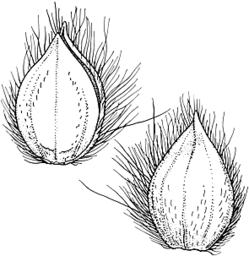Common name: Paspalum
Paspalum dilatatum Poir. APNI* 
Description: Densely tufted perennials to c. 2 m tall, often forming a tough 'crown' with leafy shoots from a knotted base of very short rhizomes; nodes glabrous, or the lower sparsely pubescent.
Lower sheaths harshly pilose towards the base, otherwise glabrous; ligule to 4 mm long, asymmetric; blade 3–12 mm wide, sparsely long-hairy at the base behind the ligule, otherwise glabrous.
Inflorescence erect or somewhat nodding, 7–25 cm long with (2–)3–7(–11) solitary racemes scattered along a slender flattened common axis; racemes ascending, spreading or drooping, 2.5–12 cm long, dense. Spikelets paired (the raceme 4-rowed), closely imbricate, widely elliptic-ovate, acute, 2.8–4 mm long and 2–2.5 mm wide. Lower glume absent. Upper glume slightly exceeding the lower lemma, scantily to copiously fringed with fine long silky hairs; lower lemma sometimes also sparsely fringed. Fertile lemma 2.2–2.6 mm long, very broadly elliptic or rotundate-elliptic, crustaceous, minutely papillose-striate.
Flowering: Summer to autumn.
Distribution and occurrence: Native of South America. Widely grown as a pasture species and now commonly naturalised in a wide variety of habitats
NSW subdivisions: *NC, *CC, *SC, *NT, *CT, *ST, *NWS, *CWS, *NWP, *SWP, *LHI
Other Australian states: *Qld *Vic. *Tas. *S.A. *W.A.
Text by S. W. L. Jacobs, Whalley, R.D.B. & Wheeler, D.J.B.
Taxon concept: Grasses of New South Wales, Fourth Edition (2008).
APNI* Provides a link to the Australian Plant Name Index (hosted by the Australian National Botanic Gardens) for comprehensive bibliographic data
***The AVH map option provides a detailed interactive Australia wide distribution map drawn from collections held by all major Australian herbaria participating in the Australian Virtual Herbarium project.
|


